Diplomatic Bluebook 2016
Chapter 3
Japan’s Foreign Policy to Promote National and Worldwide Interests
1.Means of Driving the Growth of the Japanese Economy
(1) Promotion of Economic Partnerships
Economic Partnership Agreements (EPAs) and Free Trade Agreements (FTAs) help capture the vitality of growing overseas markets and strengthen the basis of the Japanese economy, through measures such as the reduction or elimination of tariffs on goods as well as trade barriers for services, and through trade and investment rule making. The Government of Japan has concluded 16 EPAs with 20 countries. In order to achieve the goal set out in the “Japan Revitalization Strategy” to increase the FTA ratio in Japan’s trade (the ratio of trade value with countries which have FTAs already signed or entered into force with Japan to the total trade value) to 70% by 2018 from 19% in 2012, Japan is strategically promoting economic partnerships including those with the Asia-Pacific region and Europe.
Under these circumstances, in October 2015, an agreement in principle was reached on the TPP Agreement, and it was signed in February 2016. The new economic order that will be established by the TPP will serve as a basis for creating rules in the Free Trade Area of the Asia-Pacific (FTAAP), which is an even broader effort. With the signing of the TPP agreement as a driving force, Japan intends to promote other economic partnership negotiations.
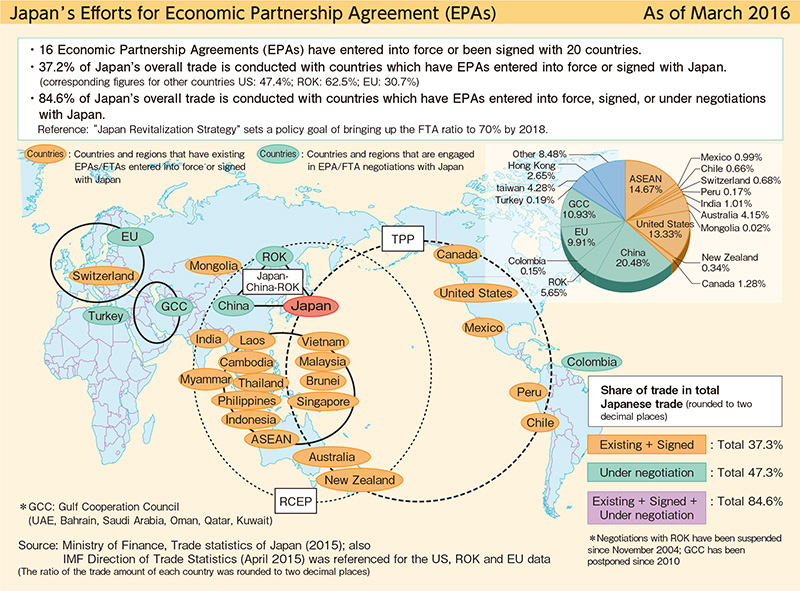
A. Multilateral Cooperations (Mega FTAs)
(a) Trans-Pacific Partnership (TPP) Agreement
The TPP Agreement is an effort to establish new trade and investment rules in the fast-growing Asia-Pacific Region. The twelve countries, namely Japan, Singapore, New Zealand, Chile, Brunei, the U.S., Australia, Peru, Vietnam, Malaysia, Mexico and Canada held negotiations and reached an agreement in principle at the TPP Ministerial Meeting held in Atlanta in October 2015, and the TPP Agreement was signed in February 2016. This Agreement establishes new 21st century rules in a wide range of areas, including customs, services, investments, intellectual property, and state-owned enterprises, and gives Japanese companies an opportunity to be more active in markets overseas, and will be a large driving force for the economic growth of Japan. Moreover, strengthening the rule of law in the economic field through the TPP Agreement with countries which share fundamental values has a strategic significance and contributes to Japan’s security and the stability of the Asia-Pacific region.
The TPP Agreement, which incorporates the Asia-Pacific region’s growth into Japan, is the core of the growth strategy of Abenomics. Japan will push for the early entry into force of the TPP agreement and the expansion of participating economies.
(b) European Union (EU)
Japan decided to launch negotiations in March 2013 with the EU, who shares fundamental values with and is a major trade and investment partner for Japan. Since the first round of negotiations was held in April 2013, fifteen rounds of negotiations were held by February 2016. Japan and the EU discussed a wide range of areas, such as trade in goods, trade in services, intellectual property rights, non-tariff measures, government procurement and investments. At the Japan-EU summit meeting, which was held on the occasion of the G20 Antalya Summit (Turkey) in November 2015, Japan and the EU shared the view to aim to reach an agreement in principle at the earliest possible time in 2016.
(c) Japan-China-ROK FTA
Japan-China-ROK FTA is a negotiation with Japan’s major trade partners: China (1st, about 20 %) and the ROK (3rd, about 6 %). The negotiation was launched in March 2013, and nine rounds of negotiations were held by January 2016. The three countries have held the negotiations over a wide range of fields including trade in goods, investment, trade in services, competition, intellectual property and electronic commerce, with the shared objective of pursuing a comprehensive and high-level FTA.
(d) Regional Comprehensive Economic Partnership (RCEP)
The RCEP negotiations aim at realizing the establishment of a broad economic integration, which covers a population of about 3.4 billion (approximately half of the world population), GDP of about 20 trillion US dollars (approximately 30% of the world GDP), and a total trade amount of about 10 trillion US dollars (approximately 30% of the total value of world trade). Since the launch of negotiations in May 2013, the leaders of ASEAN member states and their FTA partner states (six countries, namely Japan, China, the ROK, Australia, New Zealand and India), have been working together to achieve a comprehensive and high-level agreement in areas such as trade in goods, trade in services, investment, competition and intellectual property. By December 2015, three Ministerial meetings and ten rounds of negotiations had been held. At an ASEAN-related summit meeting in November, a joint statement was announced, saying the leaders welcome the promotion of substantive negotiations in the areas of trade in goods, trade in services and investments.
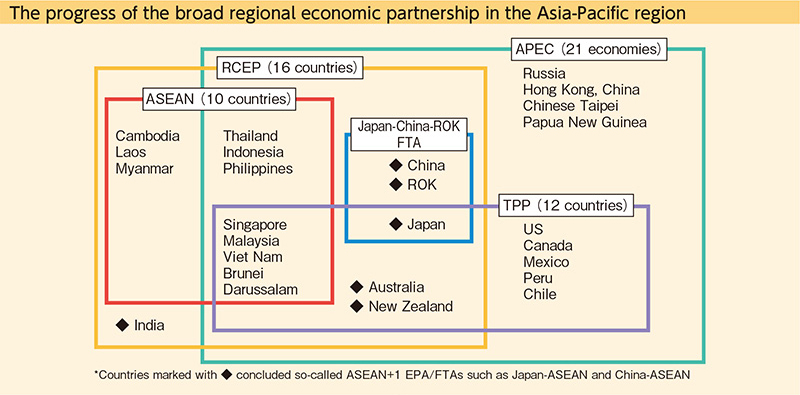
(e) FTAAP Concept
At Yokohama APEC in 2010, “Pathways to FTAAP” were agreed. It was confirmed that FTAAP should be pursued as a comprehensive high-quality free trade agreement by developing and building on ongoing regional undertakings such as ASEAN+3, ASEAN+61, and the TPP agreement. In the “Beijing Roadmap for APEC’s Contribution to the Realization of the FTAAP” adopted at the 2014 Beijing APEC Leaders’ Meeting, the launch of “collective strategic study on issues related to the realization of the FTAAP” was agreed upon. The study started in 2015 and the final report will be submitted to leaders and ministers by the end of 2016.
- 1 The current RCEP
B. Bilateral Agreements (Arranged in chronological order according to the time at which they start.)
(a) Republic of Korea (ROK)
Japan has a mutually dependent and strong economic relationship including trade and investment with the ROK, which is the most important neighboring country and shares strategic interests. Based on the recognition that an EPA with the ROK will provide both countries with a stable economic framework and bring about mutual benefits for the future, the two countries launched negotiations in 2003. Though the negotiations have been suspended since 2004, both countries have continued working level discussions.
(b) Gulf Cooperation Council (GCC)
GCC2 member states are one of the most important regions for Japan as a supplier for oil and gas and a market for infrastructure and others. The Japan-GCC FTA negotiations were launched in 2006 to reinforce economic relations with GCC member countries, but it has been suspended by the GCC side due to its internal procedures. Japan has been calling for an early resumption of the negotiations with the aim of further strengthening the economic relations with the GCC.
- 2 GCC: Gulf Cooperation Council; Consisting of six countries: Bahrain, Kuwait, Oman, Qatar, Saudi Arabia, and the United Arab Emirates (UAE)
(c) Canada
Japan launched negotiations with Canada, which shares fundamental values and has a mutually complementary economic relationship with Japan, in 2012. By December 2015, seven rounds of negotiation meetings had been held, in order to have the EPA contribute to a stable supply of energy, minerals and food to Japan.
(d) Colombia
Colombia, which is rich in resources and maintains a high economic growth rate, has concluded FTAs with various countries. From the viewpoint of improving the investment environment for Japanese companies, Japan started EPA negotiations with Colombia in 2012, and by December 2015, thirteen rounds of negotiations had been held.
(e) Turkey
With Turkey, which has high economic potential and promotes an open economy, Japan agreed to launch EPA negotiations at a bilateral Summit Meeting between Recep Tayyip Erdogan, Prime Minister of the Republic of Turkey, and Prime Minister Abe during Prime Minister Erdogan’s visit to Japan in January 2014. Japan and Turkey started EPA negotiations in December 2014. By January 2016, four rounds of negotiations had been held.
C. Signed and Existing Bilateral Agreements
(a) Mongolia
Japan launched EPA negotiations in 2012 with Mongolia, where high mid-and-long-term economic growth is expected, aiming at the improvement of the investment environment, including the energy and mineral resource sectors, as well as further expansion of the trade and investment. After seven rounds of negotiations, the two countries reached an agreement in principle in July 2014. At the Japan-Mongolia Summit Meeting, H.E. Mr. Chimed Saikhanbileg, Prime Minister of Mongolia and Prime Minister Abe signed the agreement when the Prime Minister of Mongolia visited Japan in February 2015.
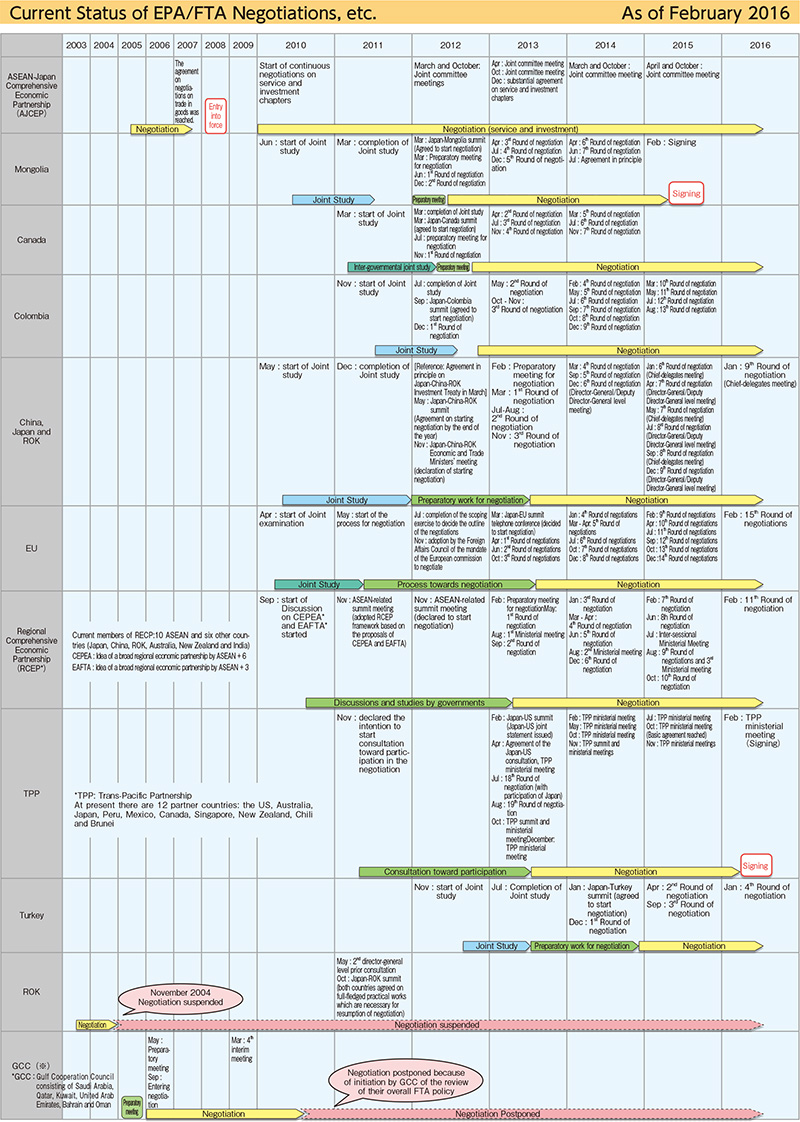
(b) Australia
Japan and Australia are important strategic partners closely collaborating in the Asia-Pacific region and in the international community. They share close relationships not only in the area of the economy as major partners in energy and food trading, but also in the areas of politics and security. The two countries decided to launch bilateral EPA negotiations at the Japan-Australia Summit Telephone Talk in 2006, and held sixteen rounds of negotiations by 2012. As a result, the agreement was signed by the leaders of both countries on the occasion of Prime Minister Abe’s visit to Australia in July 2014, and entered into force in January 2015.
(c) Existing EPAs
The existing EPAs contain provisions concerning the Joint Committee, which is a body to discuss implementation of the Agreements, and a process to review the agreements after a certain period of time since the entry into force of each Agreement. In addition, a variety of consultations are held in order to utilize the existing EPAs effectively.
E. Movement of Persons
In accordance with the EPAs, Japan has started to accept candidates for nurses and certified care workers from Indonesia, the Philippines and Vietnam. In 2015, 278 Indonesians (66 nurses and 212 care workers), 293 Filipinos (75 nurses and 218 care workers) and 152 Vietnamese (14 nurses and 138 care workers) entered Japan. In 2015, 26 nurses (11 Indonesians, 14 Filipinos, and 1 Vietnamese) and 78 care workers (47 Indonesians and 31 Filipinos) passed the national examination3. As for nurses and certified care workers candidates from Vietnam, Japan accepted the first group in June 2014 and the second group in May 2015. The total number of candidates is 290.
 Introducing Japanese Sake and Shochu at the reception to celebrate the birthday of His Majesty the Emperor(at the Embassy of Japan in France)
Introducing Japanese Sake and Shochu at the reception to celebrate the birthday of His Majesty the Emperor(at the Embassy of Japan in France)- 3 The number of Vietnamese passing the national examination was released in March 2015.
(2) Support for Japanese Companies’ Overseas Business Expansion
A. Promotion of Japanese Companies’ Overseas Business Expansion by Ministry of Foreign Affairs (MOFA) and Accompanying Diplomatic Missions Overseas
The number of Japanese companies holding overseas branches has increased in recent years and reached 68,5734 as of October 2014. The ratio of overseas manufacturing production is 22.9 % - a record-high level in 20135. One of reasons behind this is that a lot of Japanese companies supporting Japanese economic development, have embarked on expansion overseas, aiming at further cultivation of foreign markets. To incorporate vigorous economic growth abroad, mainly in Asia, into the Japanese economy, the support for Japanese companies by the government has become more important.
In light of such a situation, under the leadership of “Headquarters for the Promotion of Japanese Business Support” headed by the Foreign Minister, MOFA has engaged in tandem with the diplomatic missions overseas in supporting Japanese companies in order to promote expanding businesses overseas. In May, the both state ministers for foreign affairs were appointed as deputy chiefs and all parliamentary vice-ministers for foreign affairs as acting chiefs to strengthen the headquarters system, and a “Public-Private-Partnership Taskforce” was launched in MOFA with the deputy minister of foreign affairs (economy) as a head. In September, the Business Support Division, the Office of Infrastructure Overseas Operation Promotion, and the Investment Office, which were in the Economic Affairs Bureau, were consolidated into the Division for Promotion of Public Private Partnership, which has overall responsibility for public-private partnership operations to support Japanese companies’ to expand their businesses overseas.
At the diplomatic missions overseas, all staff, including those in responsible for Japanese business support, have supplied various pieces of information for Japanese companies and lobbied foreign governments under the leadership of ambassadors and consul-generals. MOFA also has made use of events at the diplomatic missions overseas, such as a reception to celebrate the birthday of His Majesty the Emperor, exhibited products and technology from Japanese companies through cooperation between the public and private sectors and held PR seminars for Japanese companies’ products and tasting parties, as well as exchanging meetings with local companies co-sponsored by Japanese companies through utilizing facilities of the diplomatic missions overseas.
- 4 The Statistics on the Japanese Nationals Residing Overseas, MOFA
- 5 The 44th Survey of Overseas Business Activities, METI
On October 5, 2015, the negotiations for the Trans-Pacific Partnership (TPP) reached an agreement in principle, which was signed in New Zealand on February 4, 2016. In this Feature, we introduce the TPP Agreement, which will become the new standard for trade and investment rules in the 21st century.
1 What is the TPP Agreement?
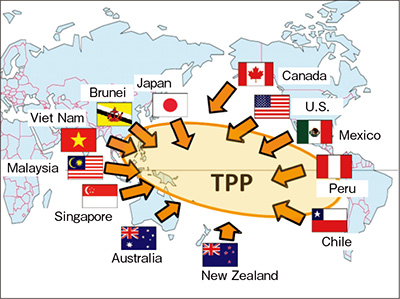 TPP Agreement participating countries
TPP Agreement participating countriesThe TPP Agreement is intended to establish new trade and investment rules in a wide range of areas, such as custom duties, services, investment, intellectual property and state-owned enterprises among the 12 Asia-Pacific countries. When the TPP Agreement enters into force, a huge “single economic zone” will be formed in the area, which can be called the growth center of the world, where people, goods, capital and information have no boundary for its movement. In this market, there live 800 million people, equivalent to about 10% of the world population. The aggregate GDP amounts to 3,100 trillion yen, accounting for approximately 40% of the world GDP. The economic scale in terms of GDP of the TPP-covered area is 1.5 times, 11 times and 6 times as large as European Union (EU), ASEAN and Japan, respectively. It may be called the dawn of a new “Asia-Pacific Century.”
2 Benefits for the Japanese economy
Japanese consumers will have access to better goods from abroad conveniently and more cheaply through the TPP Agreement. Since almost all of the customs duties imposed on Japan’s exports will be ultimately eliminated, Japanese producers should be provided with a chance to promote their high-quality products in foreign markets. Furthermore, in such fields of services and investment as finance and distribution, entry regulations will be eased under the TPP Agreement.
In the same way, the conditions for fair competition will be ensured, with respect to the environment and labor fields, and entry into the infrastructure market pertaining to government procurement will be promoted.
The added value created by Japanese producers will be evaluated correctly by properly developing these trade and investment rules. Thus, the opportunity arises for Japanese businesses, including those small- and medium-sized, to extend its reach over a dynamic market. It would provide a significant driving force for Japan’s economic growth.
3 Strategic significance
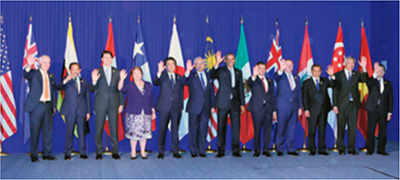 TPP Agreement Leaders? meeting (November 18, Manila, Philippines; Photo: Cabinet Public Relations Office)
TPP Agreement Leaders? meeting (November 18, Manila, Philippines; Photo: Cabinet Public Relations Office)The TPP Agreement will deepen the economic interdependence with the United States (U.S.) and other countries that share universal values such as freedom, democracy, fundamental human rights and the rule of law. Thus, the Japan-U.S. Alliance will be further strengthened. It greatly contributes to Japan’s security and the stability of the Asia-Pacific region. The trade and investment rules for the 21st century to be created by the TPP Agreement have a substantial strategic significance that it will enhance the “rule of law” to secure regional and global peace and prosperity.
4 Future development of economic partnership policy
In order to bring TPP Agreement-derived benefits into the Japanese economy, we intend to cooperate with other countries toward early entry into force of the TPP Agreement and expansion of the participating countries and regions in the future. Furthermore, with the signing of the TPP Agreement as a driving force, we intend to promote other economic partnership negotiations, such as the Japan EU Economic Partnership Agreement (EPA), Regional Comprehensive Economic Partnership (RCEP) and Japan- China- ROK Free Trade Agreement (FTA), thereby continuing to play a proactive role toward building and expanding new trade and investment rules in the world.
B. Promotion of Overseas Business Expansion of Japanese Infrastructure System
In order to respond to infrastructure demands mainly in emerging countries and promote infrastructure exports by Japanese companies, a “Ministerial Meeting on Strategy relating Infrastructure Export and Economic Cooperation,” consisting of relevant cabinet ministers with the Chief Cabinet Secretary serving as chair, was established within the Cabinet Secretariat in 2013. Since then, a total of 22 meetings by category have been held in accordance with the diplomatic schedule of the prime minister (as of December 2015), for example, meetings focused on countries or regions such as “Indonesia,” “the Mekong region,” “Central Asia” and “India” or on specific themes such as “public-private partnerships,” “railways” and “partnerships for quality infrastructure.”
The framework to promote the development of overseas business expansion of Japanese infrastructure system is maintained and reinforced. Through the schemes including the promotion of “top-level sales” led by officials including Prime Minister Abe and Foreign Minister Kishida, the reopening of JICA’s overseas investment and loans, the improved system to make use of yen credits more strategically, and the support for Japanese companies through embassies and consulates-general in various nations. MOFA has appointed 129 “Specialists in Infrastructure Projects,” who gather and consolidate information regarding infrastructure projects, in the diplomatic missions overseas in countries of focus (at 63 diplomatic missions overseas in 51 countries as of December 2015).
As concrete results of these efforts, Japanese companies or their group companies received orders for such projects as a coal-fired thermal power plant (Malaysia), a dedicated freight train railroad (India), a bridge construction and existing bridge repair project (Bangladesh), a plant for producing ammonia and urea (Uzbekistan), a metro (Qatar) and a gas-fired power and water distillation plant (Qatar).
C. Investment Treaties/Tax Conventions/Agreements on Social Security
(a) Investment Treaties
An investment treaty is an important piece of legal infrastructure to promote investments by stipulating the protection of investors and investment, enhancement of transparency in rules and expansion of opportunities, etc. In order to promote the improvement of the investment environment overseas and attract foreign investment to the Japanese market, Japan has actively engaged in the conclusion of investment treaties. In 2014, investment treaties with Papua New Guinea, Kuwait, China, the ROK (Japan-China-ROK trilateral investment treaty), Iraq, Myanmar and Mozambique each entered into force. Moreover, in 2015, respective investment treaties with Colombia, Kazakhstan and Ukraine took effect. Furthermore, investment treaties were signed with Uruguay, Oman and Iraq, which brought the total number of signed or concluded investment treaties to 28 (as of February 2016). It is also noteworthy that Japan reached an agreement in principle with Israel. Currently, negotiations of investment treaties with Angola, Algeria, Qatar, the UAE, Kenya, Ghana, Morocco and Tanzania are in progress. Japan has worked on the conclusion of EPAs (Economic Partnership Agreements) including rules concerning investment. Eleven out of 14 EPAs, including the Japan-Australia EPA, which entered into force in January 2015, contain independent chapters about investment. In addition, the Japan-Mongolia EPA, which was signed in February, and the TPP agreement, which was signed in February 2016, includes investment-related chapters. Furthermore, Japan is conducting discussions about investments in the ongoing negotiations for the following agreements: the Japan-China-ROK FTA, Regional Comprehensive Economic Partnership (RCEP), the ASEAN-JAPAN Comprehensive Economic Partnership (AJCEP), and EPAs with the EU, Canada and Turkey.
Further, within international frameworks such as the OECD and APEC, Japan has vigorously promoted the creation of multilateral rules for liberalization and facilitation of investment.
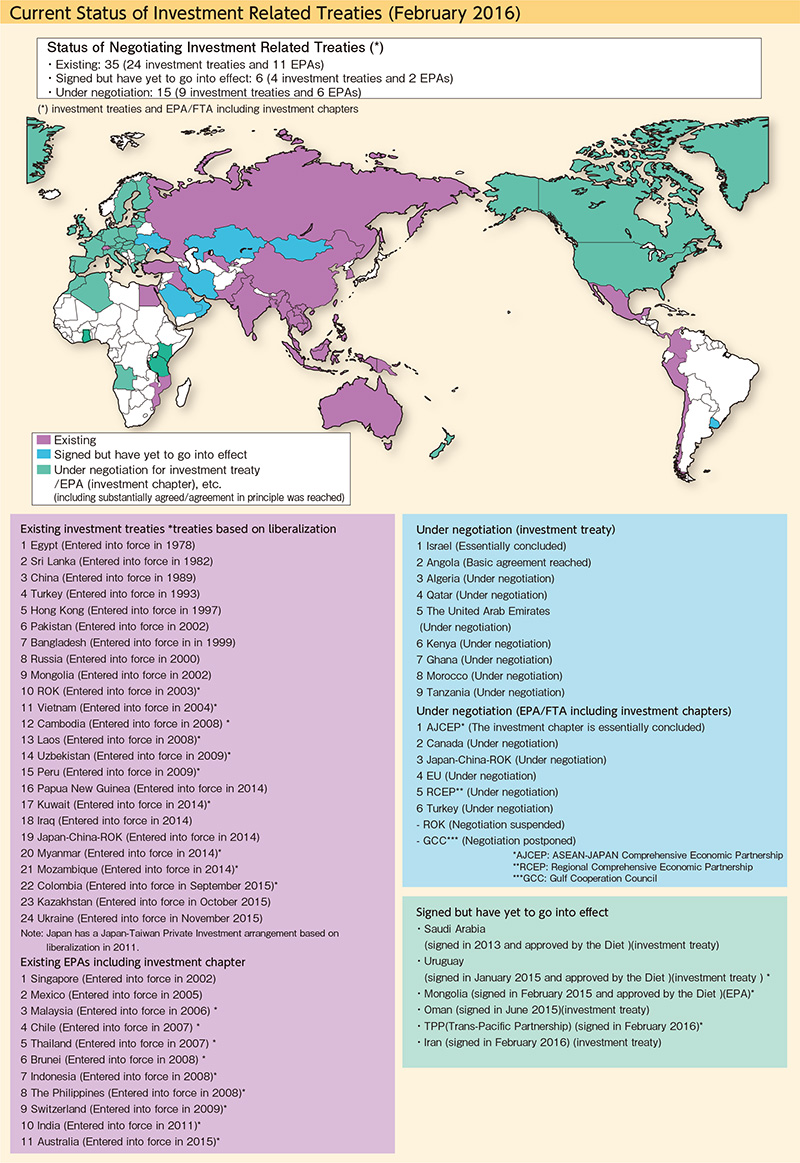
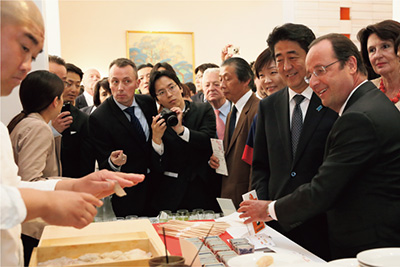 Japanese food reception at Japanese Embassy in France (Photo: Cabinet Public Relations Office)
Japanese food reception at Japanese Embassy in France (Photo: Cabinet Public Relations Office)The number of Japanese-affiliated companies based abroad increased in recent years to 68,573 as of 2015. The number of business-related consultation cases received by Japanese embassies and consulates-general reached 41,000 as of 2014. Based on these trends, the Ministry of Foreign Affairs (MOFA) in September 2015 set up a “Division for Promotion of Public-Private Partnership” in the Economic Affairs Bureau to further support overseas business by Japanese companies.
“Japanese business support officers” are currently posted at 276 diplomatic missions overseas. They are responsible for giving advice on how to do business in accordance with local business practices. “Specialists in Infrastructure Projects” are posted at diplomatic missions overseas in 51 countries, while “Japanese business support officers (in charge of food industry)” are posted at diplomatic missions overseas in 58 countries/regions. The former is responsible for overseas expansion of the area of infrastructure, while the latter is responsible for providing specific consultation services on agriculture, forestry and marine products, food and the food industry. For enquiries on overseas business operation, such as “we have had trouble with our overseas business” or “we want to use the facilities and network of diplomatic missions overseas to sell our products,” please contact the Division for Promotion of Public-Private Partnership, MOFA.
●Contact: Division for Promotion of Public-Private Partnership, Economic Affairs Bureau, MOFA
Phone: 03-3580-3311 (main number); Fax: 03-5501-8325
E-mail address: business-support@mofa.go.jp
Homepage: http://mofa.go.jp/mofaj/annai/zaigai/kigyo/ichiran_i.html
(b) Tax Conventions
Tax conventions provide an important legal basis not only to avoid international double taxation against cross-border economic activities, but also to reduce, or exempt from, taxation in the source-country on investment income (dividends, interest, and royalties), and thus promote investment exchanges. They are also important from the viewpoint of preventing international tax evasion or tax avoidance, given provisions to promote international cooperation between tax authorities through such measures as information exchange in tax matters. Japan has been actively making efforts in promoting the expansion and improvement of tax convention networks. In concrete terms, an convention with Qatar was entered into force in December, and a new tax convention with Germany and a convention with Chile were agreed in principle in July and October respectively as well as the amending protocol with India was signed in December. As a result, Japan had concluded a total number of 65 tax-related conventions (applicable to 96 countries and regions) as of the end of 2015.
(c) Agreements on Social Security
The purpose of agreements on social security is to resolve the issues of double payment and no refund of social security insurance premiums. It is expected to facilitate people-to-people exchange and strengthen further bilateral relations including economic exchanges, by unloading the burden of Japanese companies and citizens working overseas. Japan signed an agreement with the Philippines in November, which brought the total number of countries which concluded or signed such agreements on social security to 19 as of the end of 2015. In addition, in 2015, Japan held negotiations with Turkey, China and Slovakia.
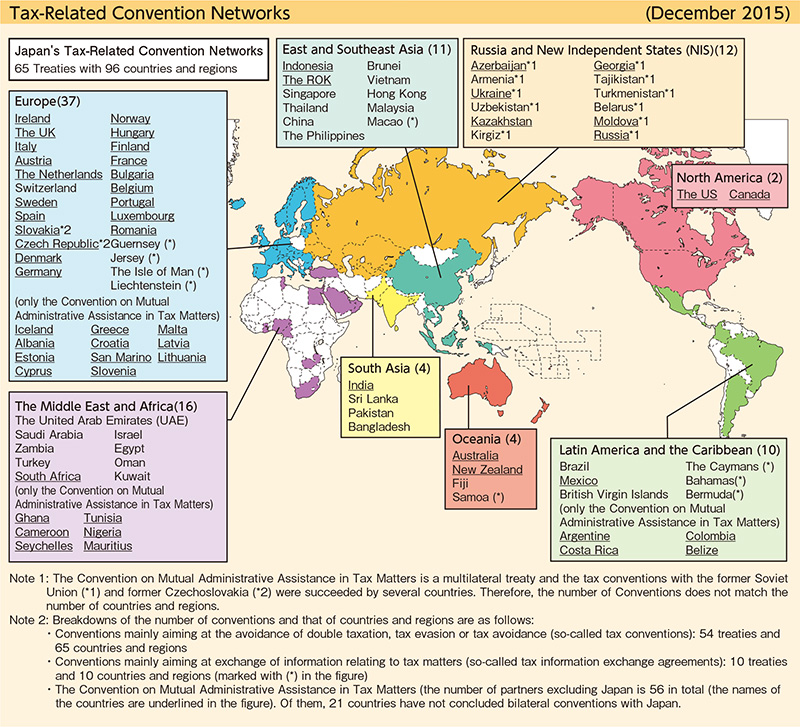
D. Intellectual Property
Strengthening the protections of intellectual property is extremely important for the promotion of technological innovation, and eventually for the development of the economy. Japan has actively participated in multilateral consultations, such as APEC, the WTO (TRIPS Council6) and the World Intellectual Property Organization (WIPO). In February 2015, Japan deposited an instrument of accession to the Geneva Act of the Hague Agreement Concerning the International Registration of Industrial Designs with WIPO. Accordingly, applicants in Japan can utilize the international registration system under the Geneva act according to the Agreement since May 2015. With regard to EPAs, Japan has aimed to include provisions concerning intellectual property to the greatest extent possible7. In addition, Japan has engaged in activities leading to the enforcement of the Anti-Counterfeiting Trade Agreement (ACTA). Also, in order to contribute to strengthening the protections of intellectual property and enhancing the abilities of government officials in developing countries in such fields as countermeasures against counterfeited or pirated goods, Japan has dispatched experts to those countries through JICA.
Moreover, MOFA has been taking measures to reinforce the protection of intellectual property rights overseas, and countermeasures against counterfeited or pirated goods. For example, for the purpose of rapidly and efficiently providing assistance for Japanese companies that are suffering from counterfeit and pirated goods, Intellectual Property Officers are assigned at almost all of the diplomatic missions overseas, so that they can advise Japanese companies and make inquiries with or suggestions to their counterpart governments.
- 6 The TRIPS Council is assigned to execute the Agreement on Trade-Related Aspects of Intellectual Property Rights (TRIPS Agreement), in particular, monitor compliance by the member states and discuss issues related to the agreement.
- 7 Agreements including provisions of intellectual property were concluded with Australia, ASEAN, Brunei, Chile, India, Indonesia, Malaysia, Mexico, Peru, the Philippines, Singapore, Switzerland, Vietnam and Thailand, and enacted accordingly.
News of the Great East Japan Earthquake that occurred on March 11, 2011, shot around the world in an instant. At that time I worked at a diplomatic mission overseas, and I heard a preliminary report on my car radio. Since then, it has been a big challenge imposed on Japan to revive the Tohoku area and make Japan a more resilient country than before the earthquake.
After the earthquake, Japan received support from about 160 countries and regions, and about 40 international organizations.
Assistance came also from developing countries, as a token of “gratitude in return for the support given by Japan so far.” Large-scale Tomodachi (friendship) Operations by U.S. forces made us reaffirm the strength of the ties in the Japan-U.S. Alliance. In October 2015, at the reception held on the occasion of entering the Yokosuka Port of the aircraft carrier “Ronald Reagan” which had been engaged in Tomodachi Operation, Reconstruction Minister Wataru Takeshita gave a speech to express gratitude to the U.S.
Japan experienced an actually unprecedented disaster, but five years have passed since then, and now reconstruction is progressing steadily. In order to get such developments communicated to foreign countries properly, I have been explaining how far the reconstruction has proceeded to foreign reporters invited by MOFA and foreign government officials visiting Japan for trainings organized by Japan International Cooperation Agency (JICA).
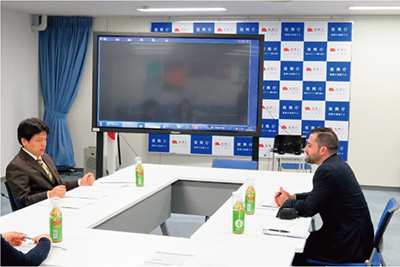 Briefing for a reporter from Kuwait
Briefing for a reporter from Kuwait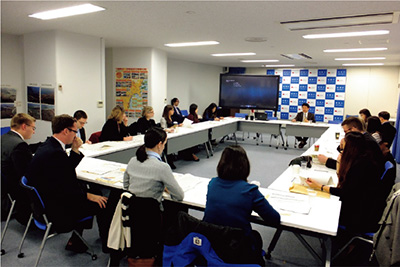 Briefing for U.S. graduate students
Briefing for U.S. graduate studentsIt is becoming especially important to get rid of the so-called reputation damage. After the accident at the Fukushima Daiichi Nuclear Power Station, about 50 countries and regions put restrictions on grocery imports from Japan. Japan patiently explained that only food products that have passed through the most severe level of radioactive substance inspections in the world are delivered onto the market. Subsequently, some of the restrictions have been relaxed or removed. In October, an event that showcases attractive food produced in Fukushima Prefecture was jointly organized by New Zealand’s Ambassador to Japan and the Governor of Fukushima. Reconstruction Minister Tsuyoshi Takagi was also present there. Air radiation dose has been getting less. We intend to make further efforts so that the remaining restrictions will be removed.
Grassroots exchanges have also been progressing between the disaster area and other countries.Women in Higashi-matsushima City, Miyagi Prefecture make use of Danish stitches (embroidery) for the reconstruction, through which interaction between the city and Denmark is deepening. Given that Japan hosts the G7 Ise-Shima Summit Meeting in 2016, the eyes of the world are expected to be on Japan. Japan hosts the Rugby World Cup in 2019, and the Tokyo Olympic and Paralympic Games in 2020. Looking ahead to these opportunities, we hope that more people from abroad will visit the Tohoku region and enjoy the local food.
(3) Promotion of the Export of Agricultural, Forestry and Fishery Products and Food
The Government of Japan set a goal of expanding the value of the export of Japanese agricultural, forestry and fishery products and food to 1 trillion yen by 2020 in the “Japan Revitalization Strategy,” which was approved at a Cabinet Meeting in June 2013. MOFA, in collaboration with relevant ministries and agencies, Japanese companies, local governments etc. and by utilizing the diplomatic missions overseas all over the world, is energetically promoting the attractive points of Japanese products at events held at embassies and consulate generals etc., such as reception to celebrate the birthday of His Majesty the Emperor.
In addition, after agreement in principle was reached regarding the TPP agreement in October, based on the “Comprehensive TPP-Related policy framework” decided in November, which stipulates “reaching the target figure of 1 trillion yen in the export of agricultural, forestry and fishery products, and food, ahead of the original target year of 2020” and “developing marketing frontiers to export high-quality Japanese agricultural, forestry and fishery products,” MOFA appointed staff in charge of supporting Japanese companies (food industry) at 58 diplomatic missions overseas in 54 countries and regions. MOFA intends to more actively promote the export of agricultural, forestry and fishery products and food in a closer collaboration with relevant ministries and agencies including the Ministry of Agriculture, Forestry and Fisheries (MAFF).
Though five years have passed since the Great East Japan Earthquake and the accident at Tokyo Electric Power Company’s Fukushima Daiichi Nuclear Power Plant (TEPCO’s, Fukushima Daiichi NPS), 37 countries and regions still have kept import restrictions on Japanese agricultural, forestry and fishery products and foods (as of February 2016). MOFA has urged other countries to consider the relaxation or abolition of import regulations as soon as possible by providing each country with timely and accurate information and using WTO frameworks based on scientific evidence in collaboration with relevant ministries and agencies to eliminate harmful rumors about agricultural and fishery products, which are the main products of the disaster area (see 2-2-1(2) C).
As a result of these efforts, import restrictions were eliminated by Thailand in May, Bolivia in November 2015 and India in February 2016. So far, 17 countries have eliminated restrictions (Canada, Myanmar, Serbia, Chile, Mexico, Peru, Guinea, New Zealand, Colombia, Malaysia, Ecuador, Vietnam, Iraq, Australia, Thailand, Bolivia, and India). Additionally, as seen in the tendency for reducing the number of areas and items subject to import suspension, restrictions were eased in 2015 by Brunei in February, the U.S. in March, April, May and August, and Russia in July, and in 2016 by the EU in January and the U.S. in January and February (as of February 2016).
MOFA will continue persistent efforts to make requests at leaders’ and ministerial levels and collaborate with relevant ministries and agencies to urge countries and regions, which maintain import restrictions, to ease or remove restrictions as soon as possible, through all routes, including bilaterally and through the WTO.



